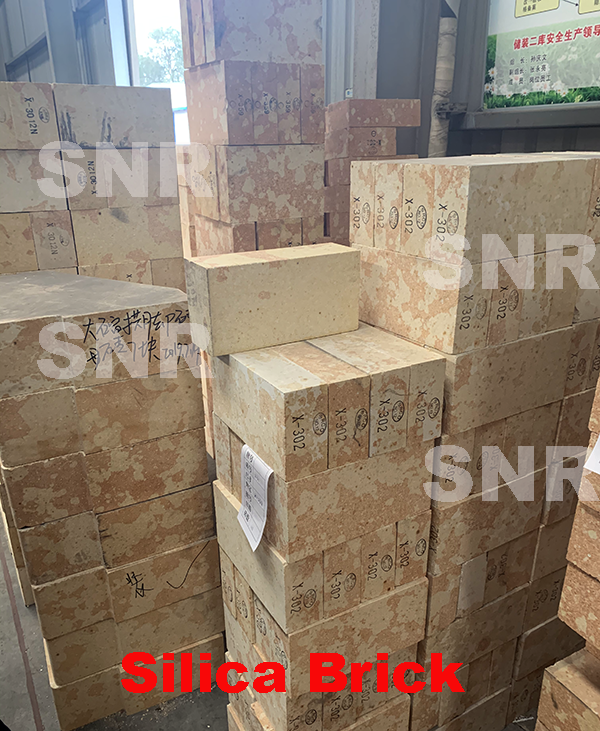
What is silica brick refractory material?
Silica refractory (Silica refractory) refers to the refractory material made of natural silica as the main raw material.
The mineral composition of silica bricks is mainly tridymite, cristobalite, a small amount of residual quartz and glass phase.
| Chemical Composition % | ||||
| SiO2 | Al2O3 | Fe2O3 | CaO | R2O |
| 93-98 | 0.5-2.5 | 0.3-2.5 | 0.2-2.7 | 1-1.5 |
| Mineral Composition % | ||||
| Tridymite | Cristobalite | Quarts | Glass Phase | |
| 3-70 | 20-80 | 3-15 | 4-10 | |


The microstructure of silica bricks is shown in the figure


These include fine tridymite particles (T), glass phase, cristobalite (C) and incompletely converted quartz particles (Q), etc.
I. What do the component minerals in silica brick affect its refractory performance?
1. First, the melting points of various crystal forms of SiO2 are different. Among them, cristobalite is the highest at 1728°C, followed by tridymite at 1670°C, and quartz is the lowest at 1600°C. Therefore, from the perspective of improving the refractoriness of the product, it is more beneficial to have a high cristobalite content.


2. Second, Different silicon oxide crystal forms have different expansions during heating and cooling.

From the perspective of expansion rate, a high content of tridymite is beneficial to improve the thermal shock resistance and volume stability of the silica brick.
3. Third, the bulk density (apparent porosity) of silica bricks also has a great influence on their thermal conductivity.


(High-density silica bricks have high thermal conductivity.)
For some silica bricks that require high thermal conductivity, such as coke oven silica bricks, additives such as CaO, Na2O, TiO2 and Fe2O3 are often added to improve their thermal conductivity. Among them, CaO has the best effect. It is reported that adding CaO can increase the thermal conductivity of silica bricks by 20%, followed by Fe2O3, and TiO2 is the worst. Since these additives have an impact on other high-temperature properties of silica bricks, it is not advisable to add too much, preferably around 2%.


The figure shows the experimental results of the erosion of silica bricks with different cristobalite contents by slag. It can be seen from the figure that with the increase of cristobalite content, the ability of silica bricks to resist slag erosion decreases.
II. Silica Brick Formation
The apparent porosity of ordinary silica bricks is between 19 and 25%. The apparent porosity of high-density silica bricks is between 10 and 20%. Their compressive strength is between 20 and 80MPa.


III. Silica Brick Production Technology
The production process of silica bricks typically involves the following steps:
1. Raw Material Preparation: The first step is to select high-quality raw materials, typically silica-rich materials such as quartzite, silica sand, or ganister. The raw materials are crushed and ground to obtain a fine and uniform particle size distribution.
2. Mixing: The crushed and ground raw materials are thoroughly mixed with water or a binder to form a plastic or semi-plastic mass. This step ensures that the raw materials are evenly distributed and well bonded.
3. Molding: The plastic or semi-plastic mass is then shaped into bricks using various molding techniques such as extrusion, pressing, or casting. The bricks can be formed in different shapes and sizes depending on the desired application.
4. Drying: The molded bricks are dried to remove excess moisture and improve their strength. This is typically done by air drying or using a drying oven. Care must be taken to control the drying process to prevent cracking or deformation.
5. Firing: The dried bricks are subjected to a high-temperature firing process known as sintering. The firing temperature for silica bricks is usually around 1450-1600°C (2642-2912°F). The bricks are loaded into kilns or furnaces, and the temperature is gradually increased to allow for proper heat distribution and controlled expansion. The firing process helps to fuse the raw materials together and transform them into a dense and stable structure.
6. Cooling and Testing: After the firing process, the kiln or furnace is allowed to cool down slowly to room temperature. The cooled silica bricks are then tested for various properties such as density, porosity, strength, and thermal conductivity to ensure they meet the desired specifications.


1.The volume is stable at high temperature, and the furnace body will not change due to temperature fluctuations
2. No pollution to glass liquid
3. Resistant to chemical attack.
4. Small bulk density.

V. Silica Brick Application
Silica bricks are favored in glass furnace applications due to their ability to withstand the harsh conditions associated with glass production, including high temperatures, chemical corrosion, and thermal cycling. Their thermal stability and resistance to the corrosive effects of molten glass and gases make them a reliable choice for lining critical areas of glass furnaces, ensuring efficient and durable operation.
1. Crown and Arch: Silica bricks are commonly used in the crown and arch areas of glass furnaces. These regions are subjected to the highest temperatures, and silica bricks can withstand the intense heat without significant deformation or structural damage.
2.Regenerator Crown: Silica bricks can be used in the crown of the regenerators, where they experience high temperatures and chemical exposure. They help maintain the integrity of the regenerator structure while efficiently storing and releasing heat.


Where can you buy the high quality silica bricks?
Zhengzhou SNR Refractory Co., Ltd (SNR) is a professional refractory materials manufacturer in China. We have over 35years experience in silica bricks producing. Comparing with our competitors such as Ruitai, Ling Nan, Sefpro, RHI etc, we can provide premium quality with reasonable price to our glass clients home and abroad.
www.snrefractory.com.
Davis Whatsapp:0086-182 0397 6036,
Email:davis@snrefractory.com.